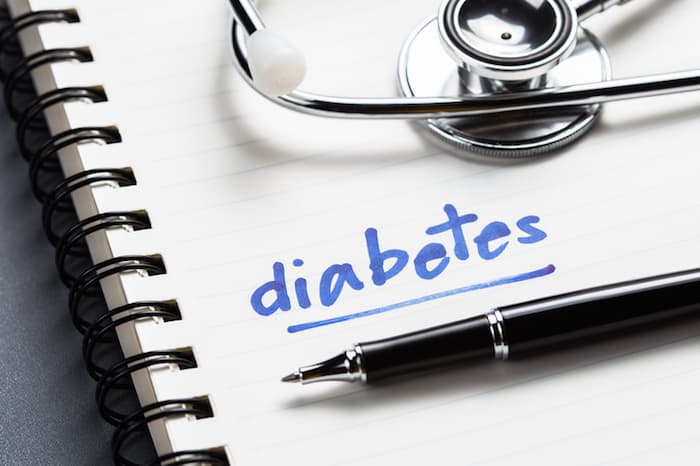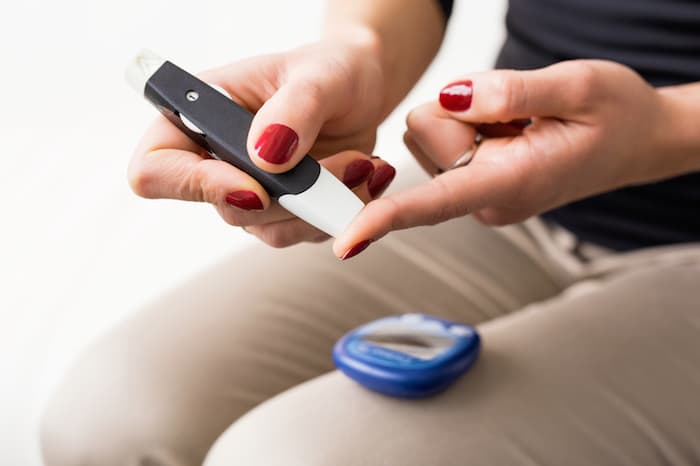- Calls to this hotline are currently being directed to Within Health or Eating Disorder Solutions
- Representatives are standing by 24/7 to help answer your questions
- All calls are confidential and HIPAA compliant
- There is no obligation or cost to call
- Eating Disorder Hope does not receive any commissions or fees dependent upon which provider you select
- Additional treatment providers are located on our directory or samhsa.gov
What is Diabulimia: Symptoms, Risk Factors, and Causes
Diabulimia, while not an official mental health diagnosis in the Diagnostic & Statistical Manual of Mental Disorders (DSM-5), is a disordered eating pattern worth being aware of. Individuals with Type I Diabetes Mellitus (DM) are at a higher risk of developing eating disorders. In fact, up to 20% of those with type 1 diabetes may experience an eating disorder in their lifetime [1]. Understanding why these two disorders often co-occur is important for early intervention.
Diabulimia Definition
First, it is important to understand what diabulimia is, as it is a unique diagnosis that many are not aware even exists. Diabulimia refers to a disorder that is “characterized by the limitation or skipping of insulin use by patients with type 1 DM, especially during adolescence, with the objective of weight control [2].”
Individuals diagnosed with type 1 diabetes do not naturally produce enough insulin, making it necessary for them to inject themselves with it to “process glucose and break down sugars from food to use as energy [3].” Skipping insulin injections results in the purging of calories through a process known as glycosuria.
In a 2017 BBC documentary, “Diabulimia: The World’s Most Dangerous Addiction,” Lead Psychiatrist for Diabetes at King’s Health Partners, Khalida Ismail, notes that diabulimia has 3 significant features:
- Diabulimia only occurs in individuals with Type 1 diabetes,
- People with diabetes have a fear that insulin causes weight gain,
- The anxiety of weight gain is so intense that it leads them to omit the quantity of insulin they take so they can lose weight [3].
Diabulimia Statistics & Facts
Research continues to grow on this disorder but the following has been determined thus far:
- “Between 11.5% and 27.5% of adolescents with type 1 diabetes meet the diagnostic criteria for an ED, most commonly bulimia nervosa or binge eating disorder [4].”
- Approximately 30% (⅓) of those with type 1 diabetes mismanage insulin to avoid weight gain or lose weight [4].
- “Insulin omission is the most favored means of weight control in people with type 1 diabetes [4].”
Diabulimia Warning Signs
Red flags that a loved one is engaging in diabulimia behaviors can be difficult to ascertain, as injection of insulin is often a self-monitored and private occurrence. Even so, the need for insulin and subsequent omission in diabulimia can lead to obvious physical and mental signs.
Physical Diabulimia Symptoms
Physical signs of diabulimia will undoubtedly manifest, as the individual requires insulin and, therefore, would display certain symptoms of insulin-deficient such as :
- Excessive thirst (also known as “polydipsia) [1].
- Excessive urination (also known as “pollakiuria”) [1].
- Weakness/Fatigue [1].
- Unexplained fluctuations in blood glucose [4].
- Frequent diabetic ketoacidosis only improves when in hospital [4].
- Irregular heart rate.
- Nausea/vomiting
- Rapid weight loss.
- Bladder infections.
- Blurred vision.
- Dry/brittle skin/hair.
Behavioral Symptoms of Diabulimia
Behavioral signs of diabulimia may be more obvious to a loved one, as they do not require testing and will signify that something harmful might be occurring. Some of these signs include:
- Expressing anxiety/fear of gaining weight.
- Praising those in small/thin bodies.
- Refusal to allow others to observe injections.
- Talking about insulin’s impact on weight.
- Expressing negative body image and/or low self-esteem.
- Isolating oneself.
- Increased symptoms or expression of depression and/or anxiety.
- Avoiding medical appointments.
Related Reading
- What is Anorexia?
- What is Bulimia?
- What is Binge Eating Disorder?
- Eating Disorders Defined
- Signs of Orthorexia
- Night Time Eating Syndrome
- What is Body Dysmorphia?
Health Consequences of Diabulimia
Diabulimia is clearly a dangerous disorder, as the individual’s type 1 diabetes diagnosis confirms that their body is not producing enough insulin on its own and that the body needs this insulin to perform optimally. The consequences of untreated and continuous diabulimia can be devastating to both the body and the mind.
Short and Long-Term Risks
Omission of insulin can lead to severe consequences ranging from short-term discomfort to long-term, life-threatening body impacts such as:
- Loss of menstrual cycle.
- Reduced immune system functioning.
- Reproductive difficulties.
- Nerve Damage.
- Numbness or weakness in limbs (neuropathy) [2].
- Impairment or loss of vision (retinopathy) [2].
- Diabetic kindness disease (nephropathy) [2].
- Osteoporosis.
- Liver disease.
- Heart disease.
- Loss of limbs.
- Death
Mortality Rates
As mentioned above, death is a very real and possible consequence of diabulimia behaviors. One study determined that mortality associated with insulin restriction appeared to occur most often due to eating disorder motivations for restriction than “other psychological distress such as anxiety, depression, fear of hypoglycemia, and diabetes distress [4].” Terrifyingly, the mortality rate for those with type 1 diabetes and an eating disorder diagnosis is 17 times higher than those with type 1 diabetes alone [5].
Diabulimia Causes
As with all eating disorders, diabulimia does not have one singular cause but many psychological, biological, and situational factors that contribute to its development. Many of the risk factors are similar to those related to eating disorder development such as being a “young female, a history of dietary restraint and dieting, weight gain, low self-esteem, and family dysfunction [4].” However, “these risks are intensified by type 1 diabetes because the foundation stone for successful management of the condition is a focus on food [4].”.
Biological Factors
Some biological factors that may predispose someone to diabulimia behaviors include:
- Having type 1 diabetes
- Family history of eating disorders.
- Being female.
- A diagnosis of anxiety or depression.
Psychological Factors
An individual’s mental wellness and psychological makeup can also contribute to the development of diabulimia. Some of these factors include:
- Perfectionist or neurotic personality traits.
- A history of trauma.
- Experiencing bullying.
- Social pressures and cultural ideals surrounding body weight, shape, appearance.
- A lack of effective coping skills.
- Struggling with anxiety or depression.
- Difficulty regulating emotions.
- Autonomy over insulin injections.
Diabulimia Treatment
As more is learned about diabulimia, an understanding of what is effective treatment is growing. One important consideration is the reason for insulin omission, as this will change what treatment method is appropriate. One study detailed, “insulin omission to avoid hypoglycemia will require different treatment to that of insulin omission linked to body image concerns and weight control [4].”
The study also specified that diabulimia may be a “method of coping with diabetes-specific distress, fear of hypoglycemia, needle anxiety, and generic psychological problems, so it is important to do a full assessment of eating behaviors, health beliefs, and predisposing and perpetuating factors before embarking on any intervention [4].”
While there are no evidence-based, diabulimia-specific treatment guidelines at this time, “the default position for the treatment of people presenting with two complex conditions has to be a multidisciplinary team approach integrating knowledge of both diabetes and eating disorders [4].”
Many of the treatments that support eating disorder recovery can be helpful for diabulimia, as they approach “the initial priorities of treatment are to stabilize eating and eliminate any purging behavior, which in the case of diabulimia is insulin omission or restriction [4].” The individual can then process the psychology behind the disorder itself.
Processing of the eating disorder motivations and beliefs must also consider the diabetes-specific triggers in supporting an individual toward recovery. For example, “The weight gain consequent upon improved glycaemic control is a risk for relapse and needs to be anticipated early in therapy [4].”
Diabulimia is a harrowing disorder, however, early intervention shows positive outcomes and it is a curable disorder.
Resources
- [1] Merwin, R. M. (2021). Eating disorders and patients with diabetes. NIH National Institute of Diabetes & Digestive and Kidney DIseases. Retrieved from https://www.niddk.nih.gov/health-information/professionals/diabetes-discoveries-practice/eating-disorders-and-the-patient-with-diabetes.
- [2] Kinik, M. F., et al. (2017). Diabulimia, a type 1diabetes mellitus-specific eating disorder. Turkish Archives of Pediatrics, 52:1.
- [3] BBC Three (2017). “Diabulimia: The World’s Most Dangerous Eating Disorder.” BBC Three. Retrieved from https://www.bbc.co.uk/programmes/p05gh0lf.
- [4] Shaban, C. (2013). Diabulimia: a mental health condition or media hyperbole? Practical Diabetes, 30:3.
- [5] Lilley, J. S. (2019). The ‘most dangerous eating disorder:’ diabulimia in T1D. Medscape & Endocrine Society. Retrieved from https://www.medscape.com/viewarticle/922788.
Page Last Reviewed and Updated By: Jacquelyn Ekern, MS, LPC on August 16, 2021
Author: Margot Rittenhouse, MS, LPC, NCC





